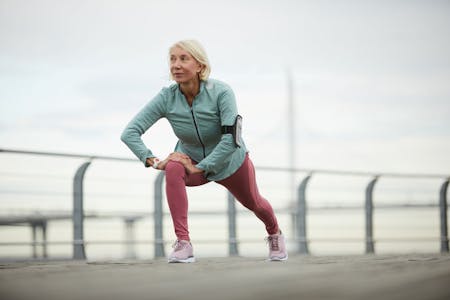
Osteoporosis literally translates to "porous bone". It is a bone condition where bones become weak and brittle due to the loss of bone mineral density and structure. Under a microscope, bones look like dense honeycombs. Bones weakened by osteoporosis have much larger holes and spaces within the honeycomb structure.
Osteopenia is basically the precursor to osteoporosis. A person with osteopenia has low bone density (low bone mass) but not to the point where it has developed into osteoporosis. According to the National Osteoporosis Foundation, approximately 33.6 million American adults (21.8 million American women and 11.8 million men) have osteopenia.
What is my Risk for Osteopenia and Osteoporosis?
Bones are living structures that change over a person's lifespan. They are at their peak density in people who are between 30 and 35 years of age. Then, they start losing bone mass. Osteopenia and osteoporosis typically occur in people over the age of 50. The age of onset depends on how healthy your bones were at their peak.
Some people with dense, healthy bones may not ever be affected by osteopenia or osteoporosis. People with a family history of osteopenia and osteoporosis, smaller-boned men and women, Caucasians and Asians are more prone to these conditions than larger-boned males and females and people of other ethnicities.
Other causes include:
- Hormonal changes such as changes that occur in women after menopause and men after andropause (the male equivalent of menopause) as well as high levels of cortisol, insulin and parathyroid hormone
- Smoking
- Consumption of caffeinated beverage (e.g., coffee), carbonated beverages (e.g., sodas, champagne, sparkling water, etc.) and excess consumption of alcohol
- Immobility due to frail health or lack of exercise
- Taking certain medications, including corticosteroids and anticonvulsant/anti-seizure medications
- Chronic inflammatory conditions, such as Rheumatoid Arthritis (RA)
- Malabsorption as a result of untreated Celiac Sprue
- Eating disorders, such as anorexia nervosa and bulimia
- Hyperthyroidism
- Vitamin D deficiency
- Taking acid-blocking drugs (e.g., Nexium, Protonix, Prevacid, Tagamet, and Zantac)
If you are a female over the age of 65 or you are at high risk for osteopenia and have suffered a fracture, you should request a bone mineral density (BMD) test from your healthcare provider. This is particularly important if you fractured a bone without trauma or by falling from a standing position. If you have osteopenia, your doctor will most likely schedule you for regular bone mineral tests every 2 to 5 years.
Early diagnosis and treatment of osteopenia are important and can help prevent osteoporosis and complications resulting from it. People with osteopenia are at higher risk for osteoporosis, a much more serious condition that can lead to fractures, hunched over posture and possibly severe pain.
Gordon PT Bone Health Program
The goal of Gordon Physical Therapy's Bone Health Program for osteopenia and osteoporosis is to enhance bone mineral density, or better yet, prevent the deterioration of bone mass (density) altogether. Treatment typically consists of physical therapist supervised weight-bearing exercises because these are the best way to strengthen your bones and muscles while reducing your risk of fracture.
Lower extremity exercises alone can help increase the BMD of the hip and great trochanter but have little effect on the spine. However, when combined with upper body exercises, there is a much more significant increase of BMD in the spine in premenopausal females and pre-andropause males. Weight-bearing exercise therapy may or may not increase BMD in postmenopausal women and post-andropause men. However, it has proven to be valuable in reducing the rate of bone deterioration.
The reason exercise works is because it strengthens bones and muscles. Plus, it also improves balance, coordination and flexibility, which is key in preventing falls that can cause painful fractures. We will design a program that is best for you and your level of osteopenia or osteoporosis.
The exercise plan we design will focus on your body mechanics and posture, balance, resistance weights and other techniques to help improve your bone health or at least slow down the rate of deterioration. Your exercise therapy plan may consist of a combination of high-impact and low-impact weight-bearing exercises or just low-impact exercises, depending on several factors including:
- Fracture Risk
- Muscle Strength
- Current Level of Physical Activity and Fitness
- Gait, Balance and Flexibility / Range of Motion (ROM)
- Other Health Factors That May Affect Your Ability to Exercise (e.g., high blood pressure (HBP), heart conditions, obesity, mobility limitations, etc.)
Have you been diagnosed with osteopenia or osteoporosis? Call us to set up an appointment for an evaluation. We'll set you up with a plan that's right for you!
